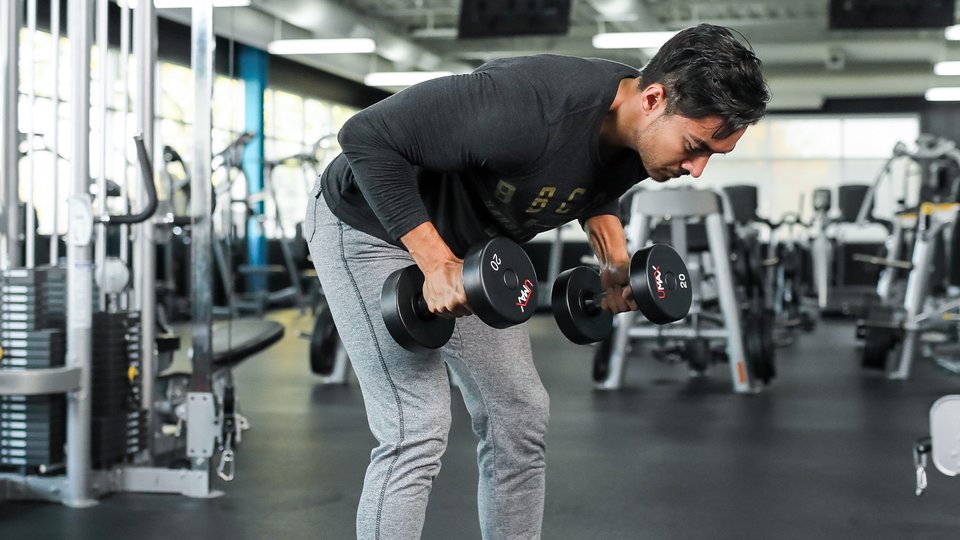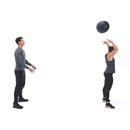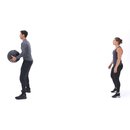It’s no secret that a variety of exercises are needed to effectively train your shoulders. Presses, raises, reverse fly variations—they’re all great and contribute in their own ways to building healthy, balanced shoulders. But these shoulder-day staples aren’t the only tools you have at your disposal! Your shoulders can also benefit from some quality time using a specific type of movement you may have been relegating to a pull or back day—if you’re doing it at all.
Best of all: You can do this move with pretty much any implement in the gym. I’m talking about the 45-degree row. Not the bent-over row or seated cable row, where you’re pulling at a right angle to your torso. Not a vertical pull-down variation, where you’re pulling parallel to the torso. Both of those angles are great for other purposes, but this time, we’re aiming right between them.
That may seem like a minor difference, but it comes with a big payoff! Research has shown that the 45-degree row has a special ability to create levels of muscle activation in the lateral delts that’s comparable to dumbbell bent-arm lateral raises, while also creating levels of muscle activation in the posterior delts comparable to dumbbell seated rear-delt flyes.[1] Plus, if you do it right, you can absolutely roast your upper traps, as well.
Does this make it “better” than raises or shrugs, or mean you should quit doing them? Absolutely not. But a triple-threat move like this definitely needs to be in your rotation for your shoulders—not just for back—and you can definitely rotate or swap it out with raises.
Here’s what you need to know.
45-Degree Row: Proper Form
Regardless of which of the versions shown below of the 45-degree row you’re doing, these same form cues apply:
- Your elbows should be at a 90-degree angle to your torso at the top of each repetition.
- Keep your elbows directly behind your hands throughout the rep. Put another way, don’t allow your wrists to bend as you pull the weight up.
- As you reach the top of each repetition, perform a shrug by driving your shoulders together behind your neck in a smooth, coordinated action with the row. This is what really hits your upper traps!
- Pause for a second at the top of each rep without allowing the front of your shoulders to round forward.
- Keep every rep under control! Don’t cheat the weight up by using your legs or lower back.
- Slowly lower the weight, taking 2-3 seconds on each rep.
- Do not allow your back to round out at any time.
Here are my five favorite variations of the 45-degree row, along with in-depth instruction on each.
Incline Bench Dumbbell 45-Degree Row
Perform these on a bench set to a 45-degree angle, facing the floor with a dumbbell in each hand. Most people perform these sitting on the seat, which forces them to bury their face in the bench pad. I don’t recommend it. You don’t want your face smashed against the bench pad where other people sweat and sit, do you? Instead, place your knees on the seat, which is far more comfortable and keeps your face above the bench.
Standing Dumbbell 45-Degree Row
With your feet roughly shoulder-width apart and your knees slightly bent, stand with your torso at a 45-degree angle to the floor. With a dumbbell in each hand, drive your elbows toward the sky to perform the 45-degree row.
Standing Barbell 45-Degree Row
Take a wide grip on the barbell with your hands placed about 5 inches (13 cm) outside of your shoulders. Aside from that, the same body positioning for the standing dumbbell 45-degree row also applies here.
Low Cable 45-Degree Row
Stand tall in a staggered stance about 2 feet in front of an adjustable cable column with a lat pull-down bar attached below your knees. With your arms straight and at a small angle away from your body, hold each side of the bar with your hands placed about 5 inches (13 cm) outside of shoulder width.
Pull the bar toward you at a 45-degree angle until your elbows reach just above shoulder height. Don’t overarch at your lower back or lean back at any time.
Low Cable Cross-over 45-Degree Row
Instead of using a lat bar as in the above variation, use two cable handles held in each hand to allow your arms to move independently. You’ll start each rep with your arms crossed, which makes you pull the weight across your body. You’ll definitely feel your shoulders, upper back, and traps light up!
How to Program the 45-Degree Row
In my article “The Complete Guide to Rows,” I give rep recommendations for different row variations, ranging from low (1-5) to medium (6-12) to high (13+). I’d put the 45-degree row in the latter two categories, especially if you are using it with a shoulder emphasis. Doing 2-4 sets of 8-20 reps, using a weight where you reach form failure at the end of each set, is a great way to program it.
If you’re training under time constraints or on the go, the 45-degree row is a great shoulder training option because it hits your lateral and posterior delts, as well as your upper traps, rather than having to hit those areas individually. This also makes it a perfect addition to total-body workouts or upper-body workouts where you have lots of other areas of your body to train.
Here’s how it could look in a full-body workout:
4
more exercises
That said, if you’re following a body-part split, the 45-degree row shouldn’t be viewed as a replacement for side and rear-delt flyes, but rather as another exercise to be used in conjunction with them to add training volume for complete shoulder development. You can rotate 45-degree rows with lateral and posterior shoulder raises each time you train shoulders, or you can use them together in the same session.
Do whatever you prefer and feel best fits your training style and goals, but get this move in the mix somewhere!
If you like in-depth coaching and tips from trainers like Nick Tumminello who truly know their stuff, try True Muscle: 9 Weeks to Elite Fitness only in Bodybuilding.com BodyFit Elite.
References
- Sweeney, Samantha P. Electromyographic analysis of the deltoid muscle during various shoulder exercises. University of Wisconsin-La Crosse Master’s Thesis: 2014-05. Published online: https://minds.wisconsin.edu/bitstream/handle/1793/70129/SweeneySamanthaThesis.pdf?sequence=1&isAllowed=y


